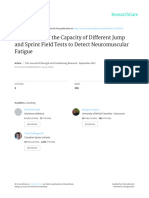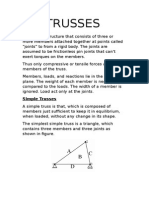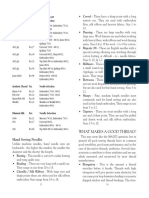Nedergaardetal Relationshiploadingaccelerometry
Uploaded by
GuilhermeNedergaardetal Relationshiploadingaccelerometry
Uploaded by
GuilhermeSee discussions, stats, and author profiles for this publication at: https://www.researchgate.
net/publication/299380576
The Relationship Between Whole-Body External Loading and Body-Worn
Accelerometry During Team-Sport Movements
Article in International Journal of Sports Physiology and Performance · February 2017
DOI: 10.1123/ijspp.2015-0712.
CITATIONS READS
19 829
6 authors, including:
Niels J Nedergaard Mark A Robinson
Copenhagen University Hospital Hvidovre Liverpool John Moores University
25 PUBLICATIONS 865 CITATIONS 128 PUBLICATIONS 3,466 CITATIONS
SEE PROFILE SEE PROFILE
Elena Eusterwiemann Barry Drust
Liverpool John Moores University University of Birmingham
3 PUBLICATIONS 91 CITATIONS 223 PUBLICATIONS 15,963 CITATIONS
SEE PROFILE SEE PROFILE
All content following this page was uploaded by Jos Vanrenterghem on 25 April 2016.
The user has requested enhancement of the downloaded file.
The relationship between whole-body external loading and body-worn
accelerometry during team sports movements
Niels J. Nedergaard1, Mark A. Robinson2, Elena Eusterwiemann2, Barry Drust1, Paulo J. Lisboa1,3
& Jos Vanrenterghem2
1 Football Exchange, Research Institute for Sport and Exercise Sciences, Liverpool John Moores University, Liverpool, UK
2 Research Institute for Sport and Exercise Science, Liverpool John Moores University, Liverpool, UK
3 School of Computing & Mathematical Sciences, Liverpool John Moores University, Liverpool, UK
As accepted for publication in International Journal of Sports Physiology and Performance,
©Human Kinetics
http://dx.doi.org/10.1123/ijspp.2015-0712
Abstract
Purpose: The aim of this study was to investigate the relationship between whole-
body accelerations and body-worn accelerometry during team sports movements.
Methods: Twenty male team sport players performed forward running, and
anticipated 45° and 90° side-cuts at approach speeds of 2, 3, 4 and 5 m·s-1. Whole-
body Centre of Mass (CoM) accelerations were determined from ground reaction
forces collected from one foot-ground-contact and segmental accelerations were
measured from a commercial GPS/accelerometer unit on the upper trunk. Three
higher specification accelerometers were also positioned on the GPS unit, the dorsal
aspect of the pelvis, and the shaft of the tibia. Associations between mechanical
load variables (peak acceleration, loading rate and impulse) calculated from both
CoM accelerations and segmental accelerations were explored using regression
analysis. In addition one-dimensional Statistical Parametric Mapping (SPM) was
used to explore the relationships between peak segmental accelerations and CoM
acceleration profiles during the whole foot-ground-contact. Results: A weak
relationship was observed for the investigated mechanical load variables regardless
of accelerometer location and task (R2 values across accelerometer locations and
tasks: peak acceleration 0.08-0.55, loading rate 0.27-0.59 and impulse 0.02-0.59).
Segmental accelerations generally overestimated whole-body mechanical load.
SPM analysis showed that peak segmental accelerations were mostly related to
CoM accelerations during the first 40-50% of contact phase. Conclusions: Whilst
body-worn accelerometry correlates to whole-body loading in team sports
movements and can reveal useful estimates concerning loading, these correlations
are not strong. Body-worn acclerometry should therefore be used with caution to
monitor whole-body mechanical loading in the field.
Keywords: CoM acceleration, GPS/accelerometry, training load, mechanical load, peak acceleration
Corresponding author:
Mr. Niels J. Nedergaard
Football Exchange, Research Institute for Sport and Exercise Sciences, Liverpool John Moores
University, Liverpool, UK. E: [email protected]. T: +44 7771 723 718
1
Introduction:
Team sports players experience high external forces on the body, in particular during the large
number of accelerations and decelerations they perform 1. As a consequence, soft tissues (bones,
cartilage, muscles, tendons and ligaments) are put under considerable mechanical load. The
accumulation of this mechanical load over time can result in structural adaptations that are beneficial
(repair, regeneration, and strengthening of the tissue) and/or detrimental (leading to overuse or acute
injury). A subtle balance of mechanical load that depends on the frequency, duration and intensity of
the external forces acting on the body is required to have beneficial adaptation yet avoid soft tissue
injury 2. Quantifying the external forces acting on the body during team sport movements in the field
could therefore help researchers and practitioners to better monitor and understand the mechanical
load experienced by players in training and matches.
Accelerometers embedded in Global positioning Systems (GPS) devices are commonly used
in professional team sport to monitor the players’ energetic demands, e.g. from the distance players
cover and the speed they run at or to estimate the external forces acting on the players’ body 3,4. The
GPS/accelerometer devices are worn on the dorsal part of the upper trunk within an elastic vest and
allow the registration of acceleration of the (upper) trunk segment. It has previously been
demonstrated that the accelerations registered from these GPS embedded accelerometers
overestimate the peak external forces acting on the players’ body during running and changes in
direction 5, or in landing and jumping tasks 6. However the relationship between trunk acceleration
from GPS accelerometers and whole-body mechanical loading during team sports movements it is
still largely unexplored.
The estimation of external forces acting on the body from trunk accelerometry is based on
Newton’s second law of motion (F whole-body = m whole-body a whole-body ) and the assumption that body-
worn accelerometers are able to measure whole-body acceleration. However because the GPS
2
accelerometers measures trunk accelerations the external forces measured are actually the external
forces acting on the trunk (F trunk = m trunk a trunk ). If however segmental accelerations from the trunk
accelerometer are related to the whole-body acceleration it could be feasible to estimate the external
forces experienced by players in the field. Whole-body accelerations, biomechanically expressed as
Centre of Mass (CoM) accelerations, do however depend on the complex inter-segmental dynamics
of the body. Since the position of the CoM relative to individual segments varies depending on the
player’s movements it remains questionable whether trunk mounted accelerometers and body-worn
accelerometry in general are able to measure the multi-segment dynamics during those movements
that are typically performed in team sports.
The relationship between segmental acceleration from body-worn accelerometry and CoM
accelerations seems to be affected by the location of the accelerometer. Accelerometers located at the
hip have for example demonstrated an acceptable association with the external forces acting on the
whole body, biomechanically expressed as the ground reaction forces (GRF), during daily life
activities 7,8. In addition accelerometers located at the hip and tibia have shown a strong association
9,10
with GRF in vertical jumping . Furthermore, higher accumulated accelerometer-based loading
values have recently been observed from a GPS accelerometer located at the hip compared to the
trunk for a 90 minute football simulation 11,12 but it remains uncertain which segmental accelerations
would better relate to whole-body mechanical loading during typical team sports movements.
Altogether, the influence of accelerometer location on the relationship between measured
accelerations and CoM accelerations during team sports movements such as running and changes in
direction is still largely unexplored. The aim of this study was therefore to investigate the association
between whole-body mechanical loading and accelerations measured from an accelerometer that is
attached to an individual body segment. This was done by investigating whether accelerations from
the body-worn accelerometers are related to variables that represent whole-body loading, and whether
3
peak accelerations are related to specific features of the CoM accelerations during the time when the
player is in contact with the ground.
Methods:
Twenty recreational male team sports athletes volunteered to participate in this study (age 22
± 4 years, height 178 ± 8 cm, mass 76 ± 11 kg). No participants had a history of severe lower limb
injuries (e.g. ACL injuries or ankle sprains). The study was approved by the Institutional Ethics
Committee and written consent was obtained from all participants.
The participants completed four forward running trials (Run), four anticipated 45° (Cut45)
and four 90° side cutting trials (Cut90) at approach speeds of 2, 3, 4 and 5 m·s-1 (± 5%) in a
randomised condition order. Approach speed was measured with photocell timing gates (Brower
Timing System, Utah, USA) that were positioned 2 m apart and 2 m from the centre of a force
platform. The participants were instructed to hit the force platform with their dominant leg (defined
as their preferred kicking leg) during the Run trials and to perform the cutting step with their dominant
leg on the force platform. An individual number of practice trials were incorporated in the warm up
routine until the participants were familiar with the different tasks and approach speeds (typically
around 4 ± 2 practise trials for each conditions).
Segmental acceleration data were collected from four body mounted accelerometers: 1) a
trunk mounted tri-axial accelerometer (KXP94, Kionex, Inc., Ithaca, NY, USA) embedded within a
commercial GPS device (MinimaxX S4, Catapult Innovations, Scoresby, Australia). This
accelerometer had a sampling frequency of 100 Hz and an output range of ± 13 g. The GPS device
was positioned on the dorsal part of the upper trunk between the scapulae within a small pocket of a
tight fitted elastic vest according to the manufactures recommendations; 2) A tri-axial wireless
laboratory accelerometer (518, DTS accelerometer, Noraxon Inc., Scottsdale, USA) with an effective
4
sampling frequency of 1000 Hz, an output range of 24 g, a total weight of 5.7 grams and 19 x 14.2 x
6.3 mm in dimension was tightly fixated to the posterior side of the GPS device using double sided
tape. Pilot work showed a difference of approximately 0.34 g in peak acceleration between a
laboratory accelerometer fixated to the posterior side of the GPS device compared to the anterior side.
The posterior location was therefore used for all measurements; 3) A tri-axial wireless accelerometer
(same specifications as accelerometer 2) was located inside the shorts worn by the participants (level
with the 5th lumbar vertebra) during the session with double sided tape. An elastic belt was strapped
around the participant’s waist and accelerometer to minimise the movement of the accelerometer
relative to pelvis; 4) A tri-axial wireless accelerometer (same specifications as accelerometer 2) was
fixed to a lightweight fibre glass plate shaped to the shaft of the tibia with double sided tape and with
elastic velcro straps tightly strapped to the front of the tibia shaft with which the subject performed
the pivot/cutting step.
The accelerometers’ static validity were tested pre and post every test session by rotating the box
through 6 degrees of freedom to detect a ± 1g acceleration due to gravity. The average resultant
acceleration were calculated over a 10 second time period for each of the sensing axes and the overall
averages were calculated from the average values of the sensing axis. A one sample t-test was used
to test if the average resultant acceleration obtained from each accelerometer were significant
different (α ≤ 0.01) from 1g pre or post every test session. Neither of the accelerometers showed a
significant difference from 1g pre or post for any of the test sessions.
Ground reaction forces (GRF) were collected from a 0.9 x 0.6 m2 Kistler force plateform (9287C,
Kistler Instruments Ltd., Winterthur, Switzerland) embedded in the floor sampling at 3000 Hz. The
GRF data were synchronised with the accelerometer data from the three laboratory tri-axial
accelerometers through an analogue board and recorded simultaneously in Qualisys Track Manager
(Qualisys AB, Gothenburg, Sweden). The Trunk accelerometer was gently tapped three times before
each trial creating three clear spikes in the acceleration traces which were used to synchronise the
Catapult acceleration data with the other acceleration data (accuracy of ± 10 ms).
5
All acceleration and GRF data were exported to Matlab (Version R2014a, The MathWorks,
Inc., Natick, MA, USA) where the whole-body CoM acceleration was determined by dividing the
GRF data by the participants’ body mass and subtracting the gravitational acceleration from the
vertical GRF data). The GRF data were filtered with a 6th order lowpass filter with a cut off frequency
of 20 Hz, while a similar lowpass filter with a cut off frequency of 60 Hz, 60 Hz and 90 Hz were
applied to the Trunk, Pelvis and Tibia acceleration data, respectively. The raw Catapult acceleration
data were not filtered, as the accelerometer data from the commercial GPS embedded accelerometers
according to the authors’ knowledge is left unfiltered when used in the field. Resultant accelerations
were calculated from the individual axes for the accelerometry and CoM acceleration data. The foot-
ground-contacts on the force platform were determined from the vertical GRF, where touch down
and take off events were created when the vertical GRF crossed a 20 N threshold. The following
variables were calculated from the accelerometry and CoM acceleration data for each trial: peak
resultant acceleration (Peak Acc); the average loading rate (Loading Rate) defined as the average
gradient of the resultant acceleration data from touch down to Peak Acc within the first 140 ms of the
stance phase; the impulse (Impulse) calculated as the integral of the resultant acceleration over time.
A linear regression analysis was used to explore the within task relationship between Peak
Acc, Loading Rate, Impulse of the CoM acceleration and accelerometry from the different
accelerometers. In addition a linear multiple regression using the three laboratory accelerometers was
used to explore if accelerometry from multiple accelerometers would improve the relationship with
the variables obtained from the CoM acceleration. The linear regression analyses were performed
using SPSS (Version 22, SPSS Inc., Chicago, IL, USA).
One-dimensional Statistical Parametric Mapping (SPM)13 was used to explore the within task
relationship between Peak Acc from the different accelerometer locations and CoM acceleration
across the entire stance phase for the Run, Cut45 and Cut90 tasks respectively. The SPM analysis is
6
an n-dimensional statistical approach of the traditionally 0-dimensional linear regression and one-
13
sample t test approach performed in SPSS . SPM analysis makes it possible to explore the
relationship without having to impose the temporal focus bias 14, that may occur in the 0-dimensional
linear regression approach described above, because of the between task variation in the GRF pattern.
The SPM analysis will reveal the periods of the stance phase where Peak Acc from the individual
accelerometers is significantly related to the CoM acceleration.
CoM acceleration(t) = (β1 (t) × Peak Acc from accelerometry) + α1 (t) + ε(t)
The slopes of the regression line between Peak Acc from the Catapult, Trunk, Pelvis and Tibia
accelerometer (β1, β2, β3 and β4, respectively) and the CoM acceleration were computed at each time
node (t) of the stance phase resulting in beta (β) trajectories (third row Figure 2). These β trajectories
were computed for each participant and were subsequently submitted to a population level one-
sample t test, yielding statistical curves (SPM{t}) for each of the four accelerometers describing the
strength and slope of the relationship between Peak Acc and CoM acceleration (fourth row Figure 2).
The significance of each SPM{t} was then determined topologically using random field theory 15,
with an alpha level at 0.0125, for each of the three tasks Run, Cut45 and Cut90, respectively.
Results:
The segmental acceleration data overestimated the CoM acceleration (Figure 1) and whole-
body mechanical loading variables regardless of task (Table 1). In general, the Catapult and Trunk
accelerations were the closest to the CoM acceleration, followed by Pelvis and Tibia accelerations
regardless of task and variable of interest. The loading variables increased with an increase in
approach speed regardless of task and accelerometer location.
7
Weak to moderate within task relationships were observed between the segmental
acceleration data and CoM acceleration data (Table 2). The Catapult and Trunk accelerometry data
most strongly predicted whole-body Peak Acc and Impulse whereas Pelvis and Tibia accelerometry
data were the strongest predictor of Loading Rate regardless of task. The addition of multiple
accelerometers only showed minor improvements of the relationship with the CoM acceleration
loading variables.
The SPM analysis for the Run and Cut45 task generally showed that peak segmental
accelerations, regardless of accelerometer location, were significantly positive related to the CoM
accelerations during the 10-75% of the stance phase with the strongest relationship from the 10-50%
of the stance phase (Figure 2 and 3). While a significantly negative relationship were observed for all
accelerometers from the 75-95% of the stance phase between peak segmental acceleration and CoM
acceleration for the Run task before take off where the CoM acceleration were low (Figure 2). For
the Cut90 task, Peak Acc and CoM acceleration was in general positive significantly related to the
CoM acceleration in the initial part of the weight acceptance phase (10-25% stance phase), apart from
the peak Tibia acceleration which also demonstrated a positive significant relationship from 70-80%
of the stance phase (Figure 4).
Discussion:
The aim of the study was to investigate the association between whole-body mechanical
loading and segmental accelerations measured from body-worn accelerometers. The segmental
acceleration data consistently overestimated the whole-body mechanical loading variables
investigated in this study regardless of task and a weak relationship was observed between segmental
acceleration and CoM acceleration. Furthermore this study showed that peak segmental acceleration
data is primarily related to whole-body mechanical loading in the 10-50% of foot-ground-contact.
8
Body-worn accelerometry only measures the acceleration of the segment it is attached to and
therefore according to our results it is inadequate to measure the acceleration of the whole body due
to the complex multi-segment motion during team sports movements. Furthermore, this linear
relationship has previously been questioned, because the relationship between lower limb segmental
acceleration and whole-body loading is influenced by the kinematics of the lower limbs at initial foot-
ground-contact 16. The difference between acceleration of individual segments and the acceleration
of the whole body can explain the consistent overestimation of peak whole-body loading from body-
worn accelerometers observed in this study. These results are in line with the weak relationship
previously observed between peak resultant accelerations from a GPS embedded trunk mounted
accelerometer and resultant peak GRF during running and change of directions at similar intensities
5
.
The peak segmental accelerations measured with the Catapult and Trunk accelerometers were
the closest to the peak CoM acceleration. This may be explained by the attenuation of the acceleration
17
signal as it travels up through the body . In addition, the trunk segment represents the largest
proportion of the whole-body mass (49.7%) compared to the pelvis (14.2%) and tibia (4.7%)
18
segments which may explain why the segmental acceleration of the trunk best represented the
acceleration of the whole body in the current study. The trunk segment’s higher mass may also explain
why the two trunk mounted accelerometers demonstrated a higher relationship with the impulse of
the CoM acceleration as the impulse represent the acceleration measured over time. This indicates
that the current practice of positioning GPS-embedded accelerometers on the trunk may be the best
location to represent the accumulated whole-body mechanical loading to which team sport players
are exposed in the field.
The results from this study showed that tibial segmental accelerations were not a good
indicator of whole-body mechanical loading. However tibial segmental accelerations could
9
potentially provide valuable information about the impact forces the lower extremities are exposed to
during initial foot-ground-contact. Studies on overuse injuries in running have for instance showed
that runners with previous stress fracture history were exposed to high initial peak ground reaction
forces and higher loading rate than runners with no previous stress fracture history 19. The potential
of using tibia mounted accelerometer to monitor initial loading rate in team sport is supported by the
results of this study as the tibia mounted accelerometer demonstrated a higher relationship with
whole-body loading rate than the trunk mounted accelerometer. Consideration should therefore be
given to accelerometer location in team sports based on the mechanical variable/s of interest.
The GPS-embedded Catapult accelerometer consistently measured lower accelerations than
the Trunk laboratory accelerometer, and the Peak Acc was slightly delayed in the Catapult data (see
Figure 1). The difference in sampling frequencies (Catapult: 100 Hz, laboratory accelerometer: 1000
Hz) may explain the systematic difference between the two trunk mounted accelerometers. The
commercial GPS embedded accelerometers’ ability to measure peak acceleration during high
frequency movements has previously been questioned when compared to laboratory accelerometers
20,21
with a higher sampling frequency . Increasing the sampling frequency of the commercial GPS
embedded accelerometers may improve their ability to represent the true accelerations experienced
in team sports.
The Statistical Parametric Mapping analysis enabled us to investigate the relationship between
peak segmental accelerations from body-worn accelerometry and CoM acceleration across the stance
phase. This analysis showed that peak segmental accelerations, regardless of accelerometer location,
were strongest related to CoM acceleration from the 10-50% of the stance phase. Peak segmental
accelerations, which previously have been used to investigate whole-body mechanical loading in
daily life activities 7,8 or as in this and previously studies to validate whole-body loading from body-
5,6
worn accelerometry , can therefore describe only part of the loading the body’s soft tissues is
10
exposed to during foot-ground-contact. Trying to use peak segmental accelerations to understand
whole-body mechanical loading during foot-ground-contact in team sport movements could therefore
be misleading. Additional information other than peak segmental accelerations is needed to better
represent the whole-body mechanical loading across the stance phase in dynamic sports movements.
Our results indicated that the relationship between peak segmental acceleration and whole-
body loading is task dependent. The difference observed between the two change-in-direction tasks
may be explained by the difference in the segmental and CoM acceleration patterns during the stance
phase with a clear initial peak after touch down in the Cut90 task (Figure 4) compared to the later
occurrence of peak CoM acceleration in the Cut45 task (Figure 3). Furthermore the CoM
accelerations of the Cut45 task indicated that approach speed changed the shape of CoM acceleration
pattern while the accelerometer trace remained consistent (Figure 3) and thereby affect the
relationship with the peak segmental acceleration.
Limitations within this study include the attachment of the individual accelerometers which
may have resulted in errors in the accelerometry signal due to the movement of the accelerometer
relative to the segment. The attachment methods and locations were chosen with a combination of
ideal an applied approach in mind for potential use in team sports. Fixing the accelerometer directly
to the skin may have improved the accuracy of the accelerometer data but this is currently less feasible
in an everyday field context. In addition, lower filtering cut-off frequency of the accelerometry data
may have improved the relationship with the CoM accelerations, as previously demonstrated for GPS-
embedded accelerometers 5,6. However it was beyond the scope of this study to determine the optimal
cut off frequency as this will most likely will be dependent on task and task intensity making it
difficult to apply optimal filter settings in the field. Importantly though, improving the relationship
with specific cut off frequencies does not change the fundamental issue with the use of body-worn
11
accelerometry to estimate CoM acceleration as it only measures the accelerations of the segment it is
attached to and not the accelerations of the whole-body.
The assumption of a simple linear relationship, based on Newton’s second law of motion,
where segmental accelerations is measured from body-worn accelerometers is not sufficient to
determine the linked multi-segment dynamics of the whole body during team sports movements in
the field. For instance when this linear assumption is used to investigate the relationship between GPS
22,23
accelerometry data and risk of soft tissue injuries . To better estimate whole-body acceleration,
the multibody dynamics of a complex system, such as the human body, must be accounted for. Future
studies should not assume that a linear approach is sufficient to estimate the mechanical external force
acting on players in the field but investigate the application of multi-segment models for this purpose
24
.
Practical Applications
Although a linear relationship exists between body-worn accelerometry (e.g. GPS
accelerometers) and whole-body accelerations the assumption of a simple linear relationship, based
on Newton’s second law of motion, should be used with caution. Practitioners should therefore be
careful when attempts are made to monitor, summarise and evaluate the mechanical load the players
are exposed to from body-worn accelerometry or associated to soft tissue injury risk. New methods
need to be developed to use body-worn accelerometry to more accurately explain whole-body
mechanical loading in dynamic team sports.
Conclusion
Whilst a weak to moderate correlation was observed between segmental accelerations from
body-worn accelerometry and can reveal useful estimations of whole-body mechanical loading in
team sports movements, particularly in the first 10-50% of foot-ground-contact, the linear relationship
12
is weak regardless of accelerometer location and task. Body-worn accelerometry only measures the
acceleration of the segment it is attached to and is inadequate to measure the acceleration of the whole
body due to the complex multi-segment motion during team sports movements. Practitioners should
consider the weak to moderate linear relationship between body-worn accelerometry and whole-body
mechanical loading when interpreting the accelerometry data in this context.
Acknowledgements:
This study was funded by the Football Exchange, Research Institute for Sport and Exercise
Science, Liverpool John Moores University, UK and partially supported by the UEFA Research Grant
Programme 2014.
13
References:
1. Bloomfield JP, R., O'Donoghue P. Deceleration movements performance during FA Premier
League soccer matches. J Sports Sci Med. 2007;6(10):6.
2. Kjaer M, Langberg H, Heinemeier K, et al. From mechanical loading to collagen synthesis,
structural changes and function in human tendon. Scand J Med Sci Sports. 2009;19(4):500-
510.
3. Boyd LJ, Ball K, Aughey RJ. The Reliability of MinimaxX Accelerometers for Measuring
Physical Activity in Australian Football. Int J Sports Physiol Perform. 2011;6(3):311-321.
4. Boyd LJ, Ball K, Aughey RJ. Quantifying External Load in Australian Football Matches and
Training Using Accelerometers. Int J Sports Physiol Perform. 2013;8(1):44-51.
5. Wundersitz DW, Netto KJ, Aisbett B, Gastin PB. Validity of an upper-body-mounted
accelerometer to measure peak vertical and resultant force during running and change-of-
direction tasks. Sports Biomech. 2013;12(4):403-412.
6. Tran J, Netto, K., Aisbett, B. and Gastin, P. VALIDATION OF ACCELEROMETER DATA
FOR MEASURING IMPACTS DURING JUMPING AND LANDING TASKS. Paper
presented at: 28th International Conference on Biomechanics in Sports; 19-23 Jul. 2010, 2010;
Marquette, Mich.
7. Meyer U, Ernst D, Schott S, et al. Validation of two accelerometers to determine mechanical
loading of physical activities in children. J Sports Sci. 2015:1-8.
8. Rowlands AV, Stiles VH. Accelerometer counts and raw acceleration output in relation to
mechanical loading. J Biomech.. 2012;45(3):448-454.
9. Setuain I, Martinikorena J, Gonzalez-Izal M, et al. Vertical jumping biomechanical evaluation
through the use of an inertial sensor-based technology. J Sports Sci. 2015:1-9.
10. Elvin NG, Elvin AA, Arnoczky SP. Correlation between ground reaction force and tibial
acceleration in vertical jumping. J Appl Biomech. 2007;23(3):180-189.
14
11. Barrett S, Midgley A, Lovell R. PlayerLoad: Reliability, Convergent Validity, and Influence
of Unit Position during Treadmill Running. Int J Sports Physiol Perform. 2014;9(6):945-952.
12. Barrett S, Midgley AW, Towlson C, Garrett A, Portas M, Lovell R. Within-Match PlayerLoad
Patterns During a Simulated Soccer Match (SAFT90): Potential Implications for Unit
Positioning and Fatigue Management. Int J Sports Physiol Perform. 2016;11(1):135-140.
13. Pataky TC. One-dimensional statistical parametric mapping in Python. Comput Method
Biomec. 2012;15(3):295-301.
14. Pataky TC, Robinson MA, Vanrenterghem J. Vector field statistical analysis of kinematic and
force trajectories. J Biomech. 2013;46(14):2394-2401.
15. Adler RJ, Taylor JE. Random Fields and Geometry. Springer-Verlag New York; 2007.
16. Derrick TR. The effects of knee contact angle on impact forces and accelerations. Med Sci
Sports Exerc. 2004;36(5):832-837.
17. Hamill J, Derrick TR, Holt KG. Shock attenuation and stride frequency during running. Hum
Movement Sci. 1995;14(1):45-60.
18. Dempster WT. Space requirements of the seated operator: geometrical, kinematic, and
mechanical aspects of the body with special reference to the limbs. Wright-Patterson Air
Force Base, Ohio: Wright Air Development Center; 1955.
19. Hreljac A. Impact and overuse injuries in runners. Med Science Sports Exerc. 2004;36(5):845-
849.
20. Kelly SJ, Murphy AJ, Watsford ML, Austin D, Rennie M. Reliability and Validity of Sports
Accelerometers During Static and Dynamic Testing. Int J Sports Physiol Perform.
2015;10(1):106-111.
21. Lake M, Nedergaard N, Kersting U. USING ACCELEROMETERS IN-BUILT INTO
PORTABLE GPS UNITS TO CAPTURE THE RAPID DECELERATIONS NEEDED FOR
TURNING MOVEMENTS IN SOCCER WORLD CONFERENCE ON SCIENCE AND
SOCCER 4.0; 2014; PORTLAND, OREGON, USA.
15
22. Ehrmann FE, Duncan CS, Sindhusake D, Franzsen WN, Greene DA. GPS and Injury
Prevention in Professional Soccer. J Strength Cond Res. 2015 (Epub Ahead of Print).
23. Colby MJ, Dawson B, Heasman J, Rogalski B, Gabbett TJ. Accelerometer and GPS-derived
running loads and injury risk in elite Australian footballers. J Strength Cond Res.
2014;28(8):2244-2252.
24. Derrick TR, Caldwell GE, Hamill J. Modeling the stiffness characteristics of the human body
while running with various stride lengths. J Appl Biomech. 2000;16(1):36-51.
16
Table 1: Peak Acc, Loading Rate and Impulse for all tasks (Run, Cut45, Cut90) at all approach speeds
(2-5 m·s-1) for CoM accelerations and the four different accelerometers mounted on the body. The
values presented are means (±SD) and n = 80 trials in total for each task. a One of the participants
was not able to perform the four Cut90 trials with an approach speed at 5 m·s-1 (n = 76 for this task).
COM Catapult Trunk Pelvis Tibia
M ± SD M ± SD M ± SD M ± SD M ± SD
Peak Acc (g)
Run 2 m·s-1 1.32 ± 0.30 2.82 ± 0.60 3.78 ± 1.13 4.56 ± 1.70 8.02 ± 2.77
Run 3 m·s-1 1.56 ± 0.33 3.33 ± 0.69 4.52 ± 1.22 5.38 ± 1.57 10.47 ± 3.65
Run 4 m·s-1 1.80 ± 0.30 2.79 ± 0.80 5.09 ± 1.32 6.38 ± 1.72 14.25 ± 3.78
Run 5 m·s-1 1.85 ± 0.41 2.82 ± 0.89 5.34 ± 1.75 7.39 ± 2.48 20.36 ± 5.39
Cut45 2 m·s-1 1.40 ± 0.34 2.81 ± 0.63 3.73 ± 1.19 4.90 ± 2.11 8.69 ± 3.54
Cut45 3 m·s-1 1.72 ± 0.38 3.41 ± 0.79 4.52 ± 1.30 6.06 ± 1.89 11.62 ± 3.86
Cut45 4 m·s-1 2.04 ± 0.42 2.92 ± 1.09 5.40 ± 1.56 8.62 ± 3.20 16.83 ± 5.19
Cut45 5 m·s-1 2.25 ± 0.49 3.10 ± 0.95 5.78 ± 1.65 11.36 ± 4.89 18.95 ± 5.99
Cut90 2 m·s-1 1.49 ± 0.37 3.10 ± 0.82 3.99 ± 1.38 5.52 ± 2.40 9.92 ± 4.15
Cut90 3 m·s-1 1.90 ± 0.50 3.89 ± 0.96 5.01 ± 1.49 8.73 ± 4.71 14.37 ± 6.27
Cut90 4 m·s-1 2.08 ± 0.51 2.86 ± 1.03 5.08 ± 1.36 10.33 ± 4.28 16.95 ± 6.26
a
Cut90 5 m·s-1 2.28 ± 0.51 3.05 ± 1.04 5.35 ± 1.56 12.53 ± 5.45 19.85 ± 5.72
Loading Rate (g·s-1)
Run 2 m·s-1 18.6 ± 4.6 31.7 ± 9.8 56.2 ± 24.2 83.6 ± 38.2 233.1 ± 111.8
Run 3 m·s-1 22.7 ± 5.5 38.3 ± 10.9 70.7 ± 27.1 116.9 ± 45.0 318.8 ± 166.8
Run 4 m·s-1 30.8 ± 11.1 34.6 ± 16.6 83.4 ± 28.6 146.4 ± 52.1 463.6 ± 176.5
Run 5 m·s-1 44.8 ± 18.4 51.9 ± 16.8 93.1 ± 34.2 191.9 ± 73.7 731.4 ± 249.9
Cut45 2 m·s-1 15.4 ± 3.8 30.8 ± 10.5 54.9 ± 26.7 87.8 ± 53.3 261.8 ± 141.3
Cut45 3 m·s-1 19.8 ± 6.5 38.4 ± 12.1 67.3 ± 28.1 126.2 ± 57.9 355.3 ± 128.3
Cut45 4 m·s-1 36.9 ± 20.2 45.8 ± 18.2 86.2 ± 36.4 202.8 ± 96.8 565.7 ± 234.3
Cut45 5 m·s-1 52.7 ± 26.2 63.6 ± 19.3 97.1 ± 36.2 266.1 ± 145.7 690.7 ± 315.3
Cut90 2 m·s-1 18.3 ± 10.7 33.7 ± 13.1 55.0 ± 28.5 92.4 ± 53.6 301.2 ± 180.1
Cut90 3 m·s-1 32.8 ± 20.9 42.8 ± 17.1 69.5 ± 26.6 154.8 ± 88.6 446.1 ± 224.2
Cut90 4 m·s-1 44.1 ± 23.6 52.8 ± 13.0 71.9 ± 24.6 199.4 ± 105.6 567.9 ± 268.5
a
Cut90 5 m·s-1 56.3 ± 21.4 65.3 ± 15.8 76.9 ± 28.6 247.2 ± 126.6 701.0 ± 237.9
Impulse (g∙s)
Run 2 m·s-1 0.25 ± 0.04 0.42 ± 0.03 0.43 ± 0.04 0.51 ± 0.04 0.75 ± 0.09
Run 3 m·s-1 0.24 ± 0.04 0.40 ± 0.03 0.41 ± 0.04 0.50 ± 0.05 0.84 ± 0.09
Run 4 m·s-1 0.24 ± 0.04 0.38 ± 0.04 0.39 ± 0.05 0.51 ± 0.05 1.00 ± 0.11
Run 5 m·s-1 0.21 ± 0.04 0.33 ± 0.05 0.34 ± 0.05 0.47 ± 0.08 1.14 ± 0.14
Cut45 2 m·s-1 0.28 ± 0.05 0.47 ± 0.04 0.47 ± 0.04 0.55 ± 0.05 0.81 ± 0.11
Cut45 3 m·s-1 0.30 ± 0.04 0.46 ± 0.05 0.47 ± 0.05 0.57 ± 0.06 0.93 ± 0.12
Cut45 4 m·s-1 0.31 ± 0.04 0.46 ± 0.06 0.49 ± 0.07 0.63 ± 0.08 1.12 ± 0.15
Cut45 5 m·s-1 0.29 ± 0.04 0.41 ± 0.07 0.46 ± 0.07 0.62 ± 0.13 1.25 ± 0.21
Cut90 2 m·s-1 0.35 ± 0.06 0.55 ± 0.08 0.56 ± 0.08 0.64 ± 0.09 0.92 ± 0.14
Cut90 3 m·s-1 0.38 ± 0.05 0.58 ± 0.08 0.60 ± 0.09 0.72 ± 0.13 1.09 ± 0.20
Cut90 4 m·s-1 0.41 ± 0.06 0.58 ± 0.09 0.68 ± 0.10 0.80 ± 0.13 1.28 ± 0.27
a
Cut90 5 m·s-1 0.38 ± 0.06 0.54 ± 0.09 0.66 ± 0.10 0.81 ± 0.12 1.44 ± 0.25
17
Table 2: Within task linear regression values (R2) for Peak Acc, Loading Rate and Impulse between
the CoM acceleration and acceleration data from the individual accelerometers and multiple
laboratory accelerometers. a One of the participants was not able to perform the four Cut90 trials with
an approach speed at 5 m·s-1.
Trunk Trunk Trunk, Hip
N Catapult Trunk Pelvis Tibia
& Hip & Shank & Shank
Peak Acc (g)
Run 320 0.26 0.20 0.08 0.26 0.21 0.31 0.31
Cut45 320 0.42 0.32 0.35 0.50 0.42 0.52 0.54
Cut90 316 a 0.55 0.46 0.48 0.34 0.60 0.53 0.61
Loading Rate (g·s-1)
Run 320 0.27 0.41 0.29 0.45 0.47 0.56 0.56
Cut45 320 0.38 0.34 0.59 0.45 0.59 0.49 0.62
Cut90 316 a 0.36 0.32 0.59 0.43 0.62 0.49 0.64
Impulse (g∙s)
Run 320 0.26 0.25 0.13 0.02 0.26 0.26 0.26
Cut45 320 0.26 0.25 0.17 0.10 0.27 0.29 0.29
Cut90 316 a 0.59 0.57 0.44 0.27 0.57 0.57 0.57
18
Figures
Figure 1: Representative examples of the resultant CoM acceleration and resultant acceleration from
the Catapult and Trunk accelerometer for the Run, Cut45 and Cut90 each with an approach speed of
5 m·s-1. All curves are normalised over the stance phase (%).
19
Figure 2: SPM1D regression analysis of the Run task for the four body-worn accelerometers, all
curves are normalised over the stance phase (%). The top row shows a representative acceleration
from the four approach speeds and accelerometer locations for one subject. The second row shows
the CoM acceleration, coloured according to the peak acceleration from the same participant for all
trials. The third row shows the β curves from all participants. The specific β curve generated from the
data in the second row is shown in black. The bottom row shows the statistical relationship (SPM{t})
between Peak Acc and CoM acceleration across the entire stance phase. Shaded areas indicate a
significant relationship (p<0.0125) between Peak Acc from the accelerometer and CoM acceleration.
20
Figure 3: SPM1D regression analysis of the Cut45 task for the four body-worn accelerometers, all
curves are normalised over the stance phase (%). See Figure 2 for a detailed explanation of the data
displayed in the individual rows.
21
Figure 4: SPM1D regression analysis of the Cut90 task for the four body-worn accelerometers, all
curves are normalised over the stance phase (%). See Figure 2 for a detailed explanation of the data
displayed in the individual rows.
22
View publication stats
You might also like
- Dynamic Stretching: The Revolutionary New Warm-up Method to Improve Power, Performance and Range of MotionFrom EverandDynamic Stretching: The Revolutionary New Warm-up Method to Improve Power, Performance and Range of Motion5/5 (2)
- Football Movement Profile Analysis and Creatine Kinase Relationships in Youth National Team PlayersNo ratings yetFootball Movement Profile Analysis and Creatine Kinase Relationships in Youth National Team Players14 pages
- Testing_and_Profiling_Athletes__Recommendations.75 (1)No ratings yetTesting_and_Profiling_Athletes__Recommendations.75 (1)22 pages
- Individual Acceleration-Speed Profile In-Situ - A Proof of Concept in Professional Football PlayersNo ratings yetIndividual Acceleration-Speed Profile In-Situ - A Proof of Concept in Professional Football Players9 pages
- 10. Testing_and_Profiling_Athletes__Recommendations.75No ratings yet10. Testing_and_Profiling_Athletes__Recommendations.7522 pages
- Sprinting Activities and Distance Covered by Top Level Europa League Soccer PlayersNo ratings yetSprinting Activities and Distance Covered by Top Level Europa League Soccer Players14 pages
- Schimpchenetal2023 Validityandreproducibilityofmatch Derivedratiosofselectedexternalandinternalloadparametersinsoccerplayers AsimplewaytomonitorfitnessNo ratings yetSchimpchenetal2023 Validityandreproducibilityofmatch Derivedratiosofselectedexternalandinternalloadparametersinsoccerplayers Asimplewaytomonitorfitness9 pages
- Design_and_Test_of_a_Custom_Instrumented_Leg_PressNo ratings yetDesign_and_Test_of_a_Custom_Instrumented_Leg_Press7 pages
- Team Sport Players Individual Acceleration-Speed Profile In-Situ: A Proof of Concept in Professional FootballNo ratings yetTeam Sport Players Individual Acceleration-Speed Profile In-Situ: A Proof of Concept in Professional Football8 pages
- Activityidentificationusingnbody-mountedsensors-reviewofclassificationtechniquesNo ratings yetActivityidentificationusingnbody-mountedsensors-reviewofclassificationtechniques34 pages
- A_new_insight-10.1136bjsports-2013-093073.17No ratings yetA_new_insight-10.1136bjsports-2013-093073.173 pages
- The Importance of GPS Features To Describe Elite Football TrainingNo ratings yetThe Importance of GPS Features To Describe Elite Football Training2 pages
- A Simple Method for Computing Sprint Acceleration Kinetics From Running Velocity Data Replication Study With Improved DesignNo ratings yetA Simple Method for Computing Sprint Acceleration Kinetics From Running Velocity Data Replication Study With Improved Design10 pages
- Hicks SCJ2019 SprinteffectivenesstrainingNo ratings yetHicks SCJ2019 Sprinteffectivenesstraining19 pages
- How To Monitor Net Plyometric Trainig StressNo ratings yetHow To Monitor Net Plyometric Trainig Stress11 pages
- ANTHROPOMETRICANDPHYSIOLOGICALCHARACTERISTICSOFYOUNGSOCCERPLAYERSACCORDINGTOTHEIRPLAYINGPOSITIONS-RELEVANCEFORCOMPETINo ratings yetANTHROPOMETRICANDPHYSIOLOGICALCHARACTERISTICSOFYOUNGSOCCERPLAYERSACCORDINGTOTHEIRPLAYINGPOSITIONS-RELEVANCEFORCOMPETI11 pages
- Haugenetal2019Sprintrunning-fromfundamentalmechanicstopractice-areviewNo ratings yetHaugenetal2019Sprintrunning-fromfundamentalmechanicstopractice-areview16 pages
- Artigo 2 BrJSportsMed 2015 Glasgow Bjsports 2014 094443 2No ratings yetArtigo 2 BrJSportsMed 2015 Glasgow Bjsports 2014 094443 24 pages
- 2015 - GATHERCOLE - Jump To Detect FatigueNo ratings yet2015 - GATHERCOLE - Jump To Detect Fatigue11 pages
- Practical Applications of Biomechanical Principles in Resistance Training: Moments and Moment ArmsNo ratings yetPractical Applications of Biomechanical Principles in Resistance Training: Moments and Moment Arms14 pages
- Velocity Based Resistance Training in Soccer 99123No ratings yetVelocity Based Resistance Training in Soccer 9912310 pages
- Morgan, R. (2014) .Technical and Physical Performance Over An English Championship League SeasonNo ratings yetMorgan, R. (2014) .Technical and Physical Performance Over An English Championship League Season12 pages
- The Importance of Muscular Strength: Training ConsiderationsNo ratings yetThe Importance of Muscular Strength: Training Considerations38 pages
- The Reliabilityand Validityof Different Methodsfor Measuring Countermovement Jump HeightNo ratings yetThe Reliabilityand Validityof Different Methodsfor Measuring Countermovement Jump Height16 pages
- Stevens, T. (2017) - Quantification of in Season Training Load Relative To Match Load in Professional Dutch Eredivisie Football PlayersNo ratings yetStevens, T. (2017) - Quantification of in Season Training Load Relative To Match Load in Professional Dutch Eredivisie Football Players11 pages
- The Relationship Between Dynamic Stability And.97681No ratings yetThe Relationship Between Dynamic Stability And.9768135 pages
- gLASGOW, 2015 - Optimal loading key variables andNo ratings yetgLASGOW, 2015 - Optimal loading key variables and4 pages
- QuantificationofinternalandexternaltrainingloadduringatrainingcampinseniorinternationalfemalefootballersNo ratings yetQuantificationofinternalandexternaltrainingloadduringatrainingcampinseniorinternationalfemalefootballers26 pages
- Moir Et Al 2017 - Mechanical Limitations To Sprinting and Biomechanical Solutions A Constraints-Led Framework For The Incorporation of Resistance Training To Develop Sprinting SpeedNo ratings yetMoir Et Al 2017 - Mechanical Limitations To Sprinting and Biomechanical Solutions A Constraints-Led Framework For The Incorporation of Resistance Training To Develop Sprinting Speed40 pages
- Match Running Performance in Young Soccer Players: A Systematic ReviewNo ratings yetMatch Running Performance in Young Soccer Players: A Systematic Review31 pages
- Lacome_IJSPP2018_MonitoringplayersreadinessusingpredictedheartrateresponsestofootballdrillsNo ratings yetLacome_IJSPP2018_Monitoringplayersreadinessusingpredictedheartrateresponsestofootballdrills21 pages
- Kingetal2010ChangesinstressandrecoveryasaresultofparticipatinginapremierrugbyleaguerepteamIntJSportsSciCoachNo ratings yetKingetal2010ChangesinstressandrecoveryasaresultofparticipatinginapremierrugbyleaguerepteamIntJSportsSciCoach18 pages
- Validation Methodology On Airbag Deployment Process of Driver Side AirbagNo ratings yetValidation Methodology On Airbag Deployment Process of Driver Side Airbag9 pages
- The Effects and Solutions of Drugs and Substance AbuseNo ratings yetThe Effects and Solutions of Drugs and Substance Abuse9 pages
- Deep Learning-Based Damage Detection of Mining Conveyor BeltNo ratings yetDeep Learning-Based Damage Detection of Mining Conveyor Belt9 pages
- Experimental Study On Bacterial Concrete With Replacement of Cement by Using Flyash M. DinushaNo ratings yetExperimental Study On Bacterial Concrete With Replacement of Cement by Using Flyash M. Dinusha5 pages
- Chemistry of Spices First Edition V A Parthasarathy download100% (10)Chemistry of Spices First Edition V A Parthasarathy download70 pages
- 177 Modern Transistor Circuits ForbeginnersNo ratings yet177 Modern Transistor Circuits Forbeginners43 pages
- Thread/Machine Needle Chart: What Makes A Good Thread?No ratings yetThread/Machine Needle Chart: What Makes A Good Thread?1 page
- Temporary Policy For Preparation of Certain Alcohol-Based Hand Sanitizer Products During The Public Health Emergency (COVID-19)No ratings yetTemporary Policy For Preparation of Certain Alcohol-Based Hand Sanitizer Products During The Public Health Emergency (COVID-19)15 pages
- Quickly download Strategic Management Of Technological Innovation 3rd Edition Schilling Test Bank in PDF with every chapter.100% (2)Quickly download Strategic Management Of Technological Innovation 3rd Edition Schilling Test Bank in PDF with every chapter.40 pages
- Bulk Density ("Unit Weight") and Voids in Aggregate: Standard Test Method ForNo ratings yetBulk Density ("Unit Weight") and Voids in Aggregate: Standard Test Method For4 pages
- 3 Hilux: Starting (W/o Smart Key System)No ratings yet3 Hilux: Starting (W/o Smart Key System)1 page

























































































